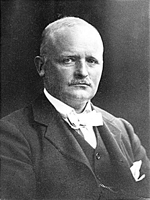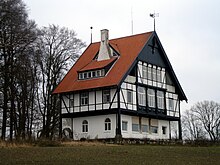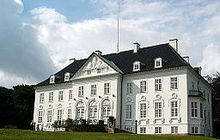Hack Kampmann

Hack Kampmann (born September 6, 1856 in Ebeltoft ; † June 27, 1920 in Frederiksberg ) was a Danish architect , royal building inspector, professor of architecture and painter . At first he had a great influence on the national romantic and later neo-classical architecture in Denmark and thus became an important and particularly distinctive architect in Aarhus and the wider area of Jutland , where many of his designs were realized.
Hack Kampmann married on September 4, 1888 in Copenhagen Johanne Holm (July 4, 1868 in Copenhagen, † March 14, 1920 ibid), daughter of the architect Hans J. Holm and Anna Dorthea Johanne Severin Nielsen.
Hack Kampmann is buried in the Vestre Kirkegård cemetery in Copenhagen.
Training and travel
He was the son of Probst Christian Peter Georg Kampmann (born August 17, 1816) and his wife Johanne Margrethe Marie, née Schmidt (born April 27, 1824). Kampmann went after an apprenticeship as a bricklayer (1873–1874) to study architecture until 1878 at the Royal Danish Art Academy (Danish: Det Kongelige Danske Art Academy Skoler for Architecture, Design and Conservation) (KADK). He became an assistant to Ferdinand Meldahl (1879) and Hans J. Holm (1880) in Frederiksberg and received a small gold medal in 1882 for the design of a bathing establishment in the Italian Renaissance style . Hack Kampmann studied from 1882 at the École nationale supérieure des beaux-arts de Paris (German: State University of Fine Arts Paris) and became an assistant to the architect Jacques Hermant . In 1884 he won the great gold medal for designing a town hall for Copenhagen .
Kampmann went on many study trips:
- 1882 to northern Italy with a grant from the Danish Den Reiersenske Fund ;
- 1881 and 1883 to Paris , where he attended the art academy and worked with the architect Jacques Hermant;
- 1884 to Sweden ;
- 1885–1886 to Germany, France and Italy financed by an academy scholarship;
- 1887 to Greece with the Danish brewer Carl Jacobsen ( Carlsberg );
- 1894 to Holland , also Spain and other countries.
Career
Since 1888 he ran his own architecture office. Since 1888 he was teaching assistant at the art academy under Hans J. Holm, he became a member of the academy in 1887 and from 1908 for life. Kampmann maintained a close relationship with the Carl Jacobsen brewer ( Carlsberg Brewery ) and succeeded the previous house architect, Vilhelm Dahlerup .
Royal Building Inspector
Kampmann came to Aarhus in 1892, where he was appointed Royal Building Inspector for Nørrejylland (German: North Jutland) on April 1st that year . He shaped the city architecturally until his death. He was also a professor at the Royal Danish Academy of Art in Copenhagen from 1908 to 1918. Hack Kampmann began as a student of the architect Hans J. Holm, who had settled in Viborg as a provincial architect . As a student of the architect Johan Daniel Herholdt , Holm was a supporter of national romanticism , here in particular the name for an architectural style in Denmark and Scandinavia between 1890 and 1910. The materials used should have a regional origin. The preferred materials in Denmark were bricks (especially red) for the masonry and roof, granite (from Bornholm ) for the base, stairs and sculptural decorations, and wood for the roof structure. The city hall in Copenhagen is considered the main work of national romanticism in Denmark. The building of the customs office in Aarhus (Danish: Aarhus Toldkammerbygning) had a similar design, skilfully constructed over the medieval city moat.
Within the movement, Kampmann continued what JD Herholdt had started. His position responded to Martin Nyrop's exhibition building and design of Copenhagen City Hall, as well as JG Clason's rationalism in Sweden. With a dissenting opinion, he wanted more independence, as can be seen in his own picturesque and irregular villa. For a long time Kampmann tried to give even the smallest detail a personal impression, that was the so-called "fun detail period", but certainly a preference that he could not always implement and therefore used naturalistic elements in the decoration. Like JD Herholdt, Kampmann attached great importance to material quality. Incidentally, his designs over the years were restless and inconsistent in response to the cultural crisis around 1900; it was necessary to create originality and inhomogeneity.
In 1908 he designed one of his most troubled works: the post and telegraph building in Aalborg . In the same year he constructed the building of the customs office in Skagen in the neo-baroque style, which incorporated the local red stone architecture. Around 1915 Kampmann went with the design of the building of the Hjørring Customs Chamber (Hjørring Toldkammer) to the style of neo-classicism . But during this period he left the realization of many designs to his sons Christian Kampmann and Hans Jørgen Kampmann , both of whom were also architects, and other employees such as Aage Rafn , whose name is inextricably linked with the Copenhagen police station (Københavns Politigård).
As a professor at the architecture school in Copenhagen, he took over the first newly opened building class, the so-called Danish class ( Danske class ) , from August 15, 1913 .
Some of its structures have been demolished, but in recent times many of its buildings have been listed.
Honors
- 1905 Member of the board of the Albertina fund of the Danish brewer Carl Jacobsen ( Carlsberg )
- 1909 Member of the selection committee of the national exhibition in Aarhus (Landsudstillingen i Århus)
- 1914–1917 chairman of the academy council
- 1909–1917 Deputy Chairman of Akademisk Architektforening (German: Academic Architects Association)
- 1917–1919 Chairman of the Akademisk Architektforening and member of the board of the Kunstindustriemuseum (Kunstindustrimuseet)
He was a judge in many architecture competitions.
Hack Kampmann is a Knight of the Dannebrog Order (Ridder af Dannebrog) and received the Gold Medal of Merit (Fortjenstmedaljen af guld) in 1900 for the design of the Aarhus Theater (Aarhus Teater). Since 1915 he received a lifelong artist pension from the tax office.
Kampmann was portrayed by the Danish painter Knud Larsen (1865–1922).
Works / buildings

- 1887–1888 Villa Miramare for the wholesaler William Salomonsen in Vedbæk ( Hovedstaden ), Strandvej 350
- 1888 fountain
- 1888–1890 Central Hospital in Hjørring , North Jutland, Bispensgade (Centralsygehus)
- 1889-1891 Provincial Archives for North Jutland in Viborg (Provinsarkiv for Nørrejylland , now: Landsarkivet for Nørrejylland)
- 1891–1893 Pastorate in Stege , Zealand (Stege Præstegård)
- 1891 Technical school in Hjørring , North Jutland (Teknisk Skole), Kongensgade
- 1890 Villa of the brewer Carl Jacobsen (Carlsberg) in Copenhagen / Vesterbro (listed)
- 1890–1895 renovations and extensions of the first Ny Carlsberg Glyptotek in Valby (Copenhagen) (listed)
- 1894 Sparkasse Hjørring, Kongensgade
- 1895–1897 Århus Customs Office (Århus Toldkammer), East Jutland, Havnegade (listed)
- 1897–1899 Hunting lodge and conversions of the manor house Kalø Hovedgård on Kalø Vig , Central Jutland (listed)
- 1897 Århus Theater (decorated by Karl Hansen Reistrup from 1897–1900 ; listed)
- 1898 Zoning plan for the lands of Marselisborg, Århus (together with state engineer Charles Ambt )
- 1898–1902 Bispetoften State Library, Århus (decorated by Karl Hansen Reistrup, a listed building)
- 1899–1902 Marselisborg Castle near Århus
- 1901–1906 Extension of the Ny Carlsberg Glyptotek , Copenhagen (after a competition, under monument protection)
- 1901 Office and laboratory building for the Carlsberg Brewery, Valby (Copenhagen)
- 1901–1902 Villa Kampen (Hack Kampmann's own villa), Strandvejen 104, Århus (listed)
- 1902–1905 St. John's Church in Trøjborg
- 1903–1905 Post and telegraph building in Århus, Kannikegade
- 1904–1906 Manor (Herregården) in Rye Nørskov
- 1904–1905 The Jutland School of Commerce (Den jydske Handelshøjskole, now: Århus Købmandsskole) in Aarhus, Hans Broges Gade
- 1905 Extension of the private bank Aarhus, Kannikegade (demolished 1929)
- 1905–1906 New building and renovation of the cathedral school in Aarhus (Aarhus Katedralskole)
- 1905–1906 Administration building of the credit union of Jutland landowners (Kreditforeningen af jydske Landejendomsbesiddere), now; Nykredit, in Viborg , North Jutland, Sct. Mathias Gade (together with Valdemar Schmidt)
- 1907–1908 Skagen customs office (Skagen Toldkammer), Skagen (listed)
- 1908–1910 Post and telegraph building in Aalborg , North Jutland, Algade 42–44 (under monument protection since 1988)
- 1909 Concept for a town with a train station (Stationsbyen) and a small farmhouse (Husmandshus; national exhibition in Århus) (demolished)
- 1909–1910 Amtmannshaus in Hjørring (Amtmandsboligen i Hjørring), Amtmandstoften 1 (under monument protection since 2010)
- 1909 Summer house for wholesaler Christian Kampmann, Lønstrup , North Jutland (demolished)
- 1910 Customs office in Viborg, Central Jutland, Banegårdspladsen (demolished)
- 1910 Court building and prison in Hornslet , Central Jutland (Hornslet Ting- og Arresthus), Tingvej 35
- 1910 Post office in Langå, East Jutland (Langå Posthus), Bredgade 53 (closed)
- 1910 Post office in Hurup , North Jutland (Hurup Posthus), Jernbanegade 2 (closed, windows changed)
- 1910 Post office in Hadsten , East Jutland (Hadsten Posthus), Østergade 6 (closed in 2006, window changed)
- 1911 Post office in Sindal , North Jutland (Sindal Posthus; closed in 1990; listed as a historical monument in 1997)
- 1911–1913 Customs office in Horsens , East Jutland (Horsens Toldkammer), now: Lager von Bestseller A / S
- 1911–1912 New tower of St. Sørens Church (Sankt Sørens Kirke) in Gammel Rye, East Jutland
- 1911–1919 Sarcophagi for the Danish King Christian IX. and Queen Louise in Roskilde Cathedral , Zealand Island
- 1913 Fountain basin for the sculpture group Danserindebrønden (German: dance around the fountain) by the Danish sculptor Rudolph Tegner in the Königsgarten in the center of Copenhagen (previously: Rosenborg Park), the sculpture group is now in Helsingør
- 1913–1918 Post Office in Løgstør , North Jutland (Løgstør Posthus)
- 1913–1915 Customs office in Frederikshavn , North Jutland (Frederikshavn Toldkammer)
- 1916 Country house for the wholesaler Christian Kampmann in Århus, Kronhjortevej
- 1915 Frederiksberg Police Station in Copenhagen, Howitzvej 30 (winner according to competition, listed)
- 1915–1926 Cathedral School in Viborg (Viborg Katedralskole) (together with his son Christian Kampmann and Johannes Frederiksen , under monument protection)
- 1916 Post Office in Viborg (Viborg Posthus), Sct. Mathias Gade 58
- 1916–1919 State Testing Institute (Statsprøveanstalten) in Copenhagen, Amager Boulevard 108 (demolished 1995)
- 1918–1926 State school in Randers , East Jutland (Randers Statsskole; together with his son Christian Kampmann and Johannes Frederiksen; demolished)
- 1918 Post Office in Skørping , North Jutland (Skørping Postbygning)
- 1918 Cordial Theater in Oslo , Stortingsgatan 16, Norway
- 1918–1919 St. Paul's Church in Hadsten (Sankt Pauls Kirke; together with his son Hans Jørgen Kampmann )
- 1918–1924 Copenhagen Police Station ( Københavns Politigård ), Polititorvet (together with Aage Rafn , Christian and Hans Jørgen Kampmann, Holger Jacobsen and Anton Frederiksen ; listed)
- 1919–1921 Brædstrup Post Office (Brædstrup Posthus), East Jutland
- 1919–1920 Reconstruction of Aalborghus Castle in Aalborg, North Jutland (Aalborghus Slot also Aalborghus)
- 1919 Conversions and extensions to the Palstrup manor near Viborg
- 1620 new tower and vestibule of the Royal Tisted Church (Kongens Tisted Kirke) in Nørager, Buerup Sogn / Zealand
- 1920 Customs office in Silkeborg , Central Jutland (Silkeborg Toldkammer); now: Post Office, Drewsensvej (together with Christian Kampmann)
- 1921 Customs office and service building Ebeltoft, now: Ebeltoft Glass Museum (together with Christian Kampmann)
Restorations
- 1889–1891 Church in Sneslev , Zealand
- 1894 Helligånd House in Randers , East Jutland
- 1895 Church in Thisted , North Jutland
- 1897–1898 Extension and restoration of the church in Nørresundby , North Jutland
- 1898 old church in Skive , Central Jutland
- 1899–1910 Restoration and extension of Budolfi Church in Aalborg, North Jutland
- 1904–1907 Aalborg Monastery, Adelgade, North Jutland
- 1907–1920 Cathedral Church in Aarhus (Danish: Århus Domkirke), Central Jutland
literature
- Ivan Kilpatrick: Hack Kampmann i Århus . Arkitekskolen i Aarhus, 1993 (Danish)
- Johan Bender : Architect Hack Kampmann . ISBN 978-87-7139-083-4 (Danish)
- Hack Kampmann . In: Carl Frederik Bricka (Ed.): Dansk biografisk Lexikon. Tillige omfattende Norge for Tidsrummet 1537-1814. 1st edition. tape 9 : Jyde – Køtschau . Gyldendalske Boghandels Forlag, Copenhagen 1895, p. 97 (Danish, runeberg.org ).
Web links
- Portrait: Hack Kampmann. Weilbach's Kunstnerleksikon (Danish)
- Hack Kampmann's buildings in Aarhus. Visit Århus (German, English)
- Kunstindeks Danmark & Weilbachs Kunstnerleksikon (Danish)
Individual evidence
- ↑ Weilbachs Kunstnerleksikon K (Danish), accessed on May 20, 2016
- ↑ Weilbachs Kunstnerleksikon K (Danish), accessed on May 20, 2016
- ↑ Weilbachs Kunstnerleksikon K (Danish), accessed on May 20, 2016
- ^ Extension building Ny Carlsberg Glyptotek. Kulturarv.dk website (Danish), accessed May 30, 2016
- ↑ Fredningsbeslutning, Kulturarvsstyrelsen: Amtmandsboligen i Hjørring. realdania.dk (Danish), accessed May 30, 2016
| personal data | |
|---|---|
| SURNAME | Kampmann, Hack |
| BRIEF DESCRIPTION | Danish architect and painter |
| DATE OF BIRTH | September 6, 1856 |
| PLACE OF BIRTH | Ebeltoft |
| DATE OF DEATH | June 27, 1920 |
| Place of death | Frederiksberg |














